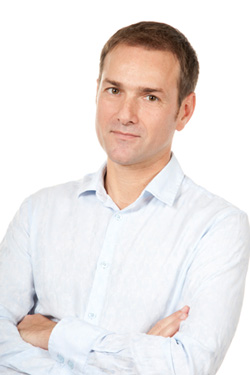Thomas Junkers graduated with a PhD in physical chemistry in 2006 from Göttingen University, where he had worked under the guidance of Prof. Michael Buback on Pulsed Laser Polymerization methods for the elucidation of chain-length effects in macroradical termination. Subsequently, he joined the Centre for Advanced Macromolecular Design at the University of New South Wales in Sydney, continuing to work on radical polymerization kinetics, but also starting to work on polymer synthesis projects. In the midlle of 2008, he followed Prof. Christopher Barner-Kowollik to the Karlsruhe Institute of Technology , working as a senior researcher until he was appointed Professor at Hasselt University early 2010. At UHasselt, he started the Polymer Reaction Design Group within the department of organic and (bio)polymer chemistry of the institute for materials research (www.imo.uhasselt.be). Recently, he received a prestigeous Odysseus grant from the Funds for Scientific Research Flanders (FWO) to support his work on the controlled synthesis of organic conducting materials. Generally, his research focuses on the design of facile polymer synthesis pathways, control methodologies for unconventional radical polymerization systems, efficient polymer conjugation reactions, state-of-the art polymer characterization as well as kinetic modelling.
Please follow the link for further information on Thomas’ research group and his recent paper published in Polymer Chemistry.
What was your inspiration in becoming a chemist?
I grew up in Leverkusen (Germany), hence since early childhood I was literally surrounded by chemistry. While such chemical industry setting may have the adverse effect on many people, it only got me deeper into the sciences. Wanting to understand what happens (and why) on a molecular level was my driving force ever since I learned what atoms and molecules are. It is this (sometimes childish) fascination I got back then that until today gives me the motivation to carry on.
What was the motivation behind the research in your recent Polymer Chemistry paper?
When we developed the Enhanced Spin Capturing Polymerization (ESCP) method and there with the Nitrone-Mediated Radical Coupling (NMRC) technique, we immediately started to extend its applicability by combining it with as many different methods as possible. When I moved to Belgium one of my first contacts became the labs in Liege, where the cobalt chemistry was developed that we have now put together with the nitrone’s spin capturing activity. The combination of both methods proved to be very success and fruitful but moreover, I enjoyed a very nice collaboration between several labs.
Why did you choose Polymer Chemistry to publish your work?
As so many others have already noted, Polymer Chemistry has rapidly become a very respected journal and I much appreciate the selection of papers and topics that are covered. I must say the proportion of articles that get my deeper interest in Polymer Chemistry is significantly larger than with many other journals in the field.
In which upcoming conferences may our readers meet you?
You will meet me in October in Hasselt at the ‘Photovoltaics at the nanoscale’ conference. The next chance will then be at the Australasian Polymer Symposium in Hobart in February.
How do you spend your spare times?
Not enough with sports. But luckily, my little son is keeping me busy – usually a much appreciated change from the academic world. Also, meeting friends and family or just listening to good music is a good way to relax. Otherwise I enjoy travelling, hiking and scuba diving.
Which profession would you choose if you were not a scientist?
When I went to university, information technology was my second choice. Today I think I would do something very different and study psychology or maybe history and politics. More realistically, however, (if I really had to choose something new) I would probably open up a sushi restaurant.













 Pr. Mathias Destarac was born in Nogent sur Marne, France, in 1970. He undertook his undergraduate studies in France at the University of Montpellier and obtained his “Diplome d’Ingenieur” in 1993 in the field of materials science. He received his PhD in 1997 from the University of Montpellier for his studies on controlled radical polymerization. He then got a postdoctoral fellow position in Pr. Matyjaszewski’s group at Carnegie Mellon University in Pittbursgh, USA, where he focused his research work on atom transfer radical polymerization. He moved to Rhodia France in late 1998 to undertake the challenge of industrial research. His Rhodia research has mainly focussed on developing the RAFT/MADIX polymerization. Over the course of his career at Rhodia, he occupied successive positions as Senior Research Fellow, Project Manager and Scientific Expert. He originated and supervised a great deal of academic collaborations on various aspects of polymerization chemistry.
Pr. Mathias Destarac was born in Nogent sur Marne, France, in 1970. He undertook his undergraduate studies in France at the University of Montpellier and obtained his “Diplome d’Ingenieur” in 1993 in the field of materials science. He received his PhD in 1997 from the University of Montpellier for his studies on controlled radical polymerization. He then got a postdoctoral fellow position in Pr. Matyjaszewski’s group at Carnegie Mellon University in Pittbursgh, USA, where he focused his research work on atom transfer radical polymerization. He moved to Rhodia France in late 1998 to undertake the challenge of industrial research. His Rhodia research has mainly focussed on developing the RAFT/MADIX polymerization. Over the course of his career at Rhodia, he occupied successive positions as Senior Research Fellow, Project Manager and Scientific Expert. He originated and supervised a great deal of academic collaborations on various aspects of polymerization chemistry.


 Didier Bourissou, born in Nice (1972) studied chemistry at the Ecole Normale Superieure in Paris. He obtained his Ph D. degree in 1998 under the supervision of G. Bertrand at the Laboratory of Coordination Chemistry, University of Toulouse (Dina Surdin Award from the French Chemical Society). He then worked as a research associate with F. Mathey and P. Le Floch at the Ecole Polytechnique in Palaiseau. He is currently CNRS Director of Research at the “Laboratoire Hétérochimie Fondamentale et Appliquée” in Toulouse (University Paul Sabatier, CNRS) and Associate Professor at the Ecole Polytechnique in Palaiseau. His research interests span a wide range of topics in main group, transition metal and polymer chemistry. These include the interplay between ambiphilic derivatives and metal fragments as well as small molecules; the coordination of indenyl rings featuring donor sidearms to get access to original low-hapticity complexes; the synthesis and applications of biodegradable polymers (new activated/functionalized monomers, controlled organo-catalyzed ring-opening polymerization, drug delivery systems). He was awarded the Bronze Medal of the CNRS (French National Research Council), the Clavel Lespiau Distinction (French Academy of Sciences) and the Acros Award (French Chemical Society) in recognition of this work.
Didier Bourissou, born in Nice (1972) studied chemistry at the Ecole Normale Superieure in Paris. He obtained his Ph D. degree in 1998 under the supervision of G. Bertrand at the Laboratory of Coordination Chemistry, University of Toulouse (Dina Surdin Award from the French Chemical Society). He then worked as a research associate with F. Mathey and P. Le Floch at the Ecole Polytechnique in Palaiseau. He is currently CNRS Director of Research at the “Laboratoire Hétérochimie Fondamentale et Appliquée” in Toulouse (University Paul Sabatier, CNRS) and Associate Professor at the Ecole Polytechnique in Palaiseau. His research interests span a wide range of topics in main group, transition metal and polymer chemistry. These include the interplay between ambiphilic derivatives and metal fragments as well as small molecules; the coordination of indenyl rings featuring donor sidearms to get access to original low-hapticity complexes; the synthesis and applications of biodegradable polymers (new activated/functionalized monomers, controlled organo-catalyzed ring-opening polymerization, drug delivery systems). He was awarded the Bronze Medal of the CNRS (French National Research Council), the Clavel Lespiau Distinction (French Academy of Sciences) and the Acros Award (French Chemical Society) in recognition of this work.